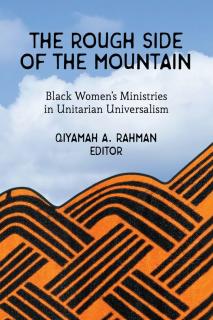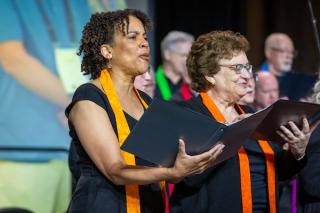Advertisement
I think of Jasmine’s beautiful long limbs as she dances. Her elongated arms floating up, down, forming curves and arcs as she twirls and leaps, dancing in concert with the others in her company. All of them seeming to float, their skirts twirling, their legs pointing out and up. Them leaping and Jasmine, especially, almost seeming to fly across the floor.
We are silent and rapt in our attention. We are witness to something that touches our hearts as the dancers tell their story, weave in movement and gesture, in posture and facial expressions—all parts of their creative expression of the divine in this space and time we have set aside as a sacred container for worship. We listen to music from the Beloved Community Chorus and we watch the dancers move. Something within me—perhaps it is my divine within—is touched and connected with the energies and movements of these Beautiful Ones here on this Sunday morning sharing the gift of themselves through the story they’re creating through movement.
We have all come,
now what shall We consciously co-create together
with All That Is
in All This Awesomeness?
Note that I did not say accomplish,
but co-create …

Excerpted with permission from The Rough Side of the Mountain: Black Women’s Ministries in Unitarian Universalism ed. Qiyamah A. Rahman (Skinner House, 2023).
This is Kwanzaa morning, and something is happening in this moment that has not happened on other Kwanzaa mornings, or any other Sunday morning. The room is packed with more people than we usually see, and in particular, more Black people than we have ever seen at one time together with us in our worship space.
When I consider our congregation and all we profess to be, all we aspire to be, I am filled with joy by those in this room, the variegated multitude cramming the seats. I am filled with great joy that the offering before us seems to fill up the eager hearts waiting to celebrate, wanting to know something more about this place—Durham, North Carolina, ancestral land of the Eno and Saponi—wanting to feel affirmed in the possibility of who we in these United States could possibly be, or at least who we in this particular room at this particular time might possibly be.
I am glad that what is being offered and created this Sunday morning seems worthy of the eager hearts in the room. And yet I also feel a sense of mourning and grief that once this Sunday is over, once the beautiful music, dancing, and food of the karamu that will transform our coffee hour into a magnificent feast has ceased, this Sunday’s community dispersed, we will become again as we were—white-cultured—like a rubber band that has snapped back to its original shape.
And so what might we co-create in full embrace of
this knowing that
we are possibility
from a sudden burst of light?
That we are the light?
So what might we co-create in the
love power and wisdom of the
I Am Spirit
that is Life?
“Worship is my favorite aspect of congregational life, the joining of the gathered community.”
Worship is my favorite aspect of congregational life, the joining of the gathered community. And my role is to help hold open sacred space, creating the container in which an experience of the holy might enter—however it is experienced—for those who gather. And so creating and offering a worship service, no matter what role I play, is a very precious and sacred practice for me.
I come to worship with my heart wide open, thinking, What might we co-create together? in my womanist experiences and understandings, along with everyone else and theirs. And in this I also wonder, What might the community need today? Pastoral care, ritual, comfort, the warmth of welcome, uplift, agitation, a call to action?
In our co-creating, we are all challenged by the pluralism of our congregations and the diversity of race, identities, privilege, class, seen and unseen disabilities, and beliefs. What does it mean to shift the focus from the needs of the dominant culture and to consider the needs of all who are in the room, and those we wish to invite in, in hopes that not only will all feel their needs have been addressed, but that when people of non-dominant groups show up they might feel compelled to return again because they instinctively sense, Yes, there is something here for me?
But co-creating worship requires some moving forward and some moving back. Recognizing that while it’s okay for worship to have some structure, the structure might also shift because the gathered community has shifted. So if we are authentically meeting the needs of the gathered body in its entirety, which some of our congregations have said they’re eager to see become more diverse, would not worship itself become more diverse as we form Beloved Community?
“The beauty of the sacred container that holds our worship services is in its potential, in its challenge, and in its possibility to hold diverse forms and structures.”
One thing about being a queer Black woman leading worship is that I am admittedly attuned to the needs of the most marginalized, though I concede that I must address my privilege at times as well. So when Black people, Indigenous people, Latinx, Asian, and other people of color start finding us and decide to return or remain and white folks complain about worship not being like what they’ve been accustomed to, it’s difficult to bear at times. Can’t someone else be in the center for a Sunday or even many Sundays? Isn’t this space to be shared by all? Black people, Indigenous people, Latinx, Asian, and other people of color often suspend their worship needs and desires and expand their capacity for accepting music and other forms that they might enjoy a little less or feel a little less comfortable with. But the beauty of the sacred container that holds our worship services is in its potential, in its challenge, and in its possibility to hold diverse forms and structures. We don’t attempt to do this all at one time, and I am not talking about misappropriating other groups’ sacred rituals and forms that have nothing to do with us or in ways that are clearly out of context. I am talking about co-creating worship with integrity, which means that I, as a queer Black clergywoman, can bring the fullness of who I am to the worship experience, while embracing my charge to address the needs of the fully gathered community.
I would like to see more people bring curiosity to worship, asking themselves, as they sit in a service that’s not what they expected: What might I learn about this? What’s the opportunity for my heart to open in a new way? Everyone needs this practice: What’s here for me in this moment? Where is the holy for me in all this? Is the sacred not present because I don’t care for the music today or someone is shouting Amen or Ashe or clapping their hands—or choosing not to do so?
At my congregation, we take care to create our worship so that it is not exclusively for the marginalized or voyeuristic for the majority, but rather an opportunity for all to open their hearts in ways they had not considered and to experience the fullness of who we in Beloved Community have now become.
Co-creation by all of us of the sacred container that is worship space—sometimes moving forward, sometimes pulling back, in creatively generous, effortless motion—is the worship my heart imagines is possible and what I am always determined to bring forward.
